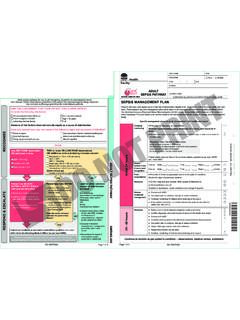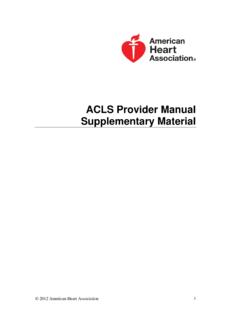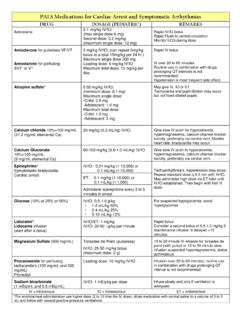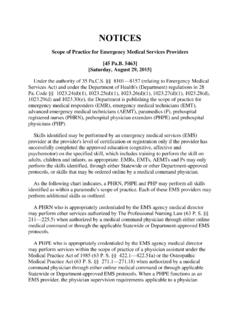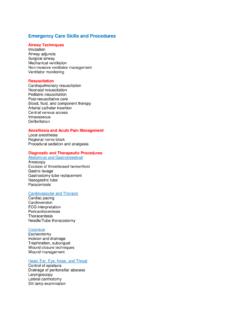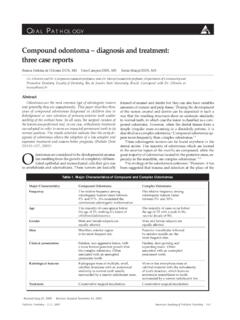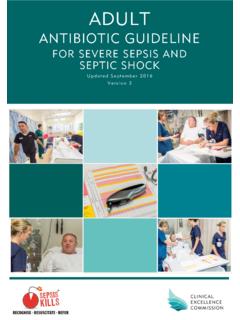Transcription of Supplemental Injections z ÆLocal - Columbia University
1 1 Supplemental InjectionsSupplemental injection TechniqueszIntraosseous anesthesia Localanesthetic is deposited into the cancellous bone that supports the teethzPeriodontal Ligament InjectionzIntraseptal InjectionzIntraosseous InjectionzIntrapulpal InjectionPeriodontal Ligament InjectionzProvides pulpal and soft-tissue anesthesia in a localized area (one tooth) of the mandible without producing extensive soft-tissue ( Tongue and lower lip) the extensive soft tissue anesthesia, patients may be concerned that they are not adequately injectionzLocal anesthetic is diffused apically and into the marrow spaces surrounding the solution in notforced apically through the periodontal tissues because of the increased hydrostatic pressure being exerted in a confined space. This could cause avulsion of a IIminijectPDL injectionzThe most frequent post- injection complications reported include mild discomfort and sensitivity to biting and percussion for 2 or 3 most common causes of post- injection discomfort are.
2 ZToo rapid injection (producing edema and slight extrusion of the tooth sensitivity on biting)zInjection of excessive volumes of local anesthetic into the site2 PDL InjectionzNerves anesthetized terminal nerve ending at the site of injection and at the apex of the toothzAreas anesthetized bone, soft tissue, and apical and pulpal tissues in the area of injectionPDL injection anesthesia of one or two teeth in a of isolated teeth in 2 mandibular for whom residual soft-tissue anesthesia in in which regional block anesthesia is a possible aid in diagnosis of pulpal an adjunctive technique after nerve block anesthesia if partial anesthesia is presentPDL injection or inflammation at the site of teeth, when the permanent tooth bud is hypoplasia has been reported to occur in a developing permanent tooth when a PDL injection was administered to the primary tooth above appears to be little reason for use of PDL technique in primary teeth because infiltration anesthesia and the incisive nerve block are who requires a numb sensation for psychological comfortAdvantages of PDL anesthesia of the lip, tongue, and other soft tissues, thus facilitating treatment in multiple quadrants during a single dose of local anesthetic necessary to achieve anesthesia ( ml per root) alternative to partially successful regional nerve block onset of profound pulpal and soft-tissue anesthesia (30 seconds)
3 Traumatic than conventional block suited for procedures in children, extractions, and periodontal and endodontic single-tooth and multiple quadrant proceduresDisadvantages of PDL needle placement is difficult to achieve in some of local anesthetic solution into the patient s mouth produces an unpleasant pressure or overly rapid injection may break the glass special syringe may be pressure can produce focal tissue injection discomfort may persist for several potential for extrusion of a tooth exists if excessive pressure or volumes are injection TechniquezArea of insertion: along the long axis of the tooth to be treatedzTarget area: depth of gingival sulcuszLandmarkszRoot(s) of the toothzPeriodontal tissueszProcedurezStabilize the syringe along the long axis of the root to be anesthetizedzWith the bevel of needle on the root, advance the needle apically until resistance is metzDeposit ml of local anesthetic solution in a minimum of 20 seczIf tooth is multi-rooted, remove the needle and repeat the procedure on the other roots3 Indicators of Success of PDL InjectionzSignificant resistance to the deposition of the local anesthetic solutionzIschemia of the soft tissues adjacent to the injection siteFailures of PDL or inflamed tissues.
4 The pH and vascularity changes at the apex and periodontal tissues minimize the effectiveness of the local is not retained. In this case, remove the needle and reenter at a different site until of local anesthetic is deposited and retained in the root must be anesthetized with ml of InjectionzSimilar in technique to the PDL injection . zUseful for providing osseous and soft-tissue anesthesia and hemostasis for periodontal curettage and surgical flap be effective when the PDL injection is not an option (infection, acute inflammation)zThe path of diffusion of the anesthetic solution is most likely through the medullary boneIntraseptal InjectionzNerves anesthetized terminal nerve endings at the site of injection and in the adjacent hard and soft tissueszAreas anesthetized Bone, soft tissue, root structure in the area of injectionzIndication when both pain control and hemostasis are desired for soft-tissue and osseous periodontal treatmentzContraindicatedif infection or severe inflammation at the injection siteIntraseptal injection of lip and tongue volumes of local anesthetic bleeding during the surgical (<30-sec)
5 Onset of postoperative on periodontally involved teeth (avoids infected pockets)Intraseptal injection tissue punctures may be taste of the duration of pulpal anesthesia; limited area of soft-tissue experience necessary for success4 Technique for Intraseptal InjectionzArea of insertion/target area center of the interdental papilla adjacent to the tooth to be treatedzLandmarks papillary triangle, about 2 mm below the tip, equidistant from adjacent teethzStabilize the syringe and orient the needle correctlyzFrontal plane: 45 degrees to the long axis of the toothzSagital plane: at right angle to the soft tissuezBevel ~ facing the apex of the toothzSlowly inject a few drops of local anesthetic as the needle enters the soft tissue and advance the needle until contacting the bonezApplying pressure, push the needle slightly deeper (1-2 mm) into the interdental septumzDeposit ml of local anesthetic in a minimum of 20 secNote the position of the needle apical to the apex of the papillary triangle for the intraseptal technique.
6 Intraseptal InjectionFailures of Anesthesia Intraseptal InjectionzInfected or inflamed tissues. Changes in tissue pH minimize the effectiveness of the local anestheticzSolution not retained in the tissue. To correct: advance the needle further into the septalbone and re-administer to mlIntraosseous InjectionDeposition of local anesthetic solution into the interproximal bone between two teethIntraosseous InjectionzNerves anesthetized terminal nerve endings at the site of injection and in the adjacent soft and hard tissueszAreas anesthetized Bone, soft tissue, and root structure in the area of injectionzIndication pain control for dental treatment on a single or multiple teeth in a quadrantzContraindications infection or severe inflammation at the injection InjectionzBecause the intraosseous injection site is relatively vascular.
7 It is suggested that the volume of local anesthetic delivered be kept to the recommended minimum to avoid possible overdosezBecause of the high incidence of palpitations noted when vasopressor-containing local anesthetics are used, a plain local anesthetic is recommended5 intraosseous InjectionzAdvantageszLack of lip and tongue anesthesiazAtraumaticzImmediate (<30 seconds) onset of actionzFew postoperative complicationszDisadvantageszRequires a special syringezBitter taste of the anesthetic drug (with leakage)zOccasional difficulty in placing anesthetic needle into predrilled holezHigh occurrence of palpitations when vasopressor-containing local anesthetic is usedIntraosseous not inject into infected not inject too not inject too much not use a vasopressor-containing local anesthetic unless necessaryzFailures of or inflamed to perforate cortical bone- If cortical bone is not perforated within 2 seconds, it is recommended that the drilling be stopped and an alternative site be used*Intravascular injection is extremely unlikely, although the area injected into is vascular.
8 Slow injection of the recommended volume of solution is important!* intraosseous InjectionComplicationszPalpitationszPost - injection painzunlikely, but NSAIDS may be used for post- injection discomfortzFistula formationzSeparation of the perforator or cannulazPerforation of the lingual plateDuration of AnesthesiazPulpal anesthesia ~15-30 min Stabident System 2 parts: a perforator, a solid needle that perforates the cortical plate of bone with a conventional slow-speed contra-angle handpiece, and an 8 mm long, 27-gauge needle that is inserted into this predrilled hole for anesthetic administration X-tip Composed of a drill and guide sleeve. The drill leads the guide sleeve through the cortical plate, after which it is separated and withdrawn. The guide sleeve remains in the bone and accepts a 27-gauge ultrashort needle Intraflow Combines the steps the anesthetic cartridge is attached to a standard four-hole air hose and controlled by a rheostat.
9 The intraflow is a modified slow-speed handpiece that consists of 4 main parts A needle or drill that makes the perforation through the bone and delivers the local anesthetic A transfuser that acts as a conduit from the local anesthetic cartridge to the needle or drill A latch tip or clutch that drive and governs the rotation of the needle or drill A motor or infusion drive that powers the rotation of the needle or drill and, while holding the local anesthetic cartridge in place, powers the infusion plungericallinethroughtheintLATERAL PERFORATIONG eneral RuleImagine a horizontal line along the gingival margins of the teeth and a vertical line through the interdental papilla. A point about 2mm apical to where these lines meet is usually a suitable site for a lateral selection in the mandible(a) Inject distal rather than mesial, where possible, because a smaller dose suffices.
10 In most cases, a mesial injection will provide adequate anesthesia, but in a small number it will not.(b) Avoid perforating between the lower central incisors (because good cancellous spaces are not present in this area).(c) Avoid the mental foramen area. Preferably, a site between the bicuspids should be avoided, even though a perforation at a distance of 2mm from the gingival margin would usually be well clear of the mental foramen. Site selection in the maxilla(a) Avoid perforating between the upper central incisors (because good cancellous spaces are not present in this area).(b) Avoid perforating into the maxillary sinus. Penetrating the maxillary sinus would not cause permanent damage but local anesthesia would not be achieved. VERTICAL PERFORATIONG eneral RuleEdentulous areas may be treated, if preferred, by choosing a site on the alveolar crest (where the cortical plate is thinnest) to provide a vertical perforation rather than a lateral perforation.










